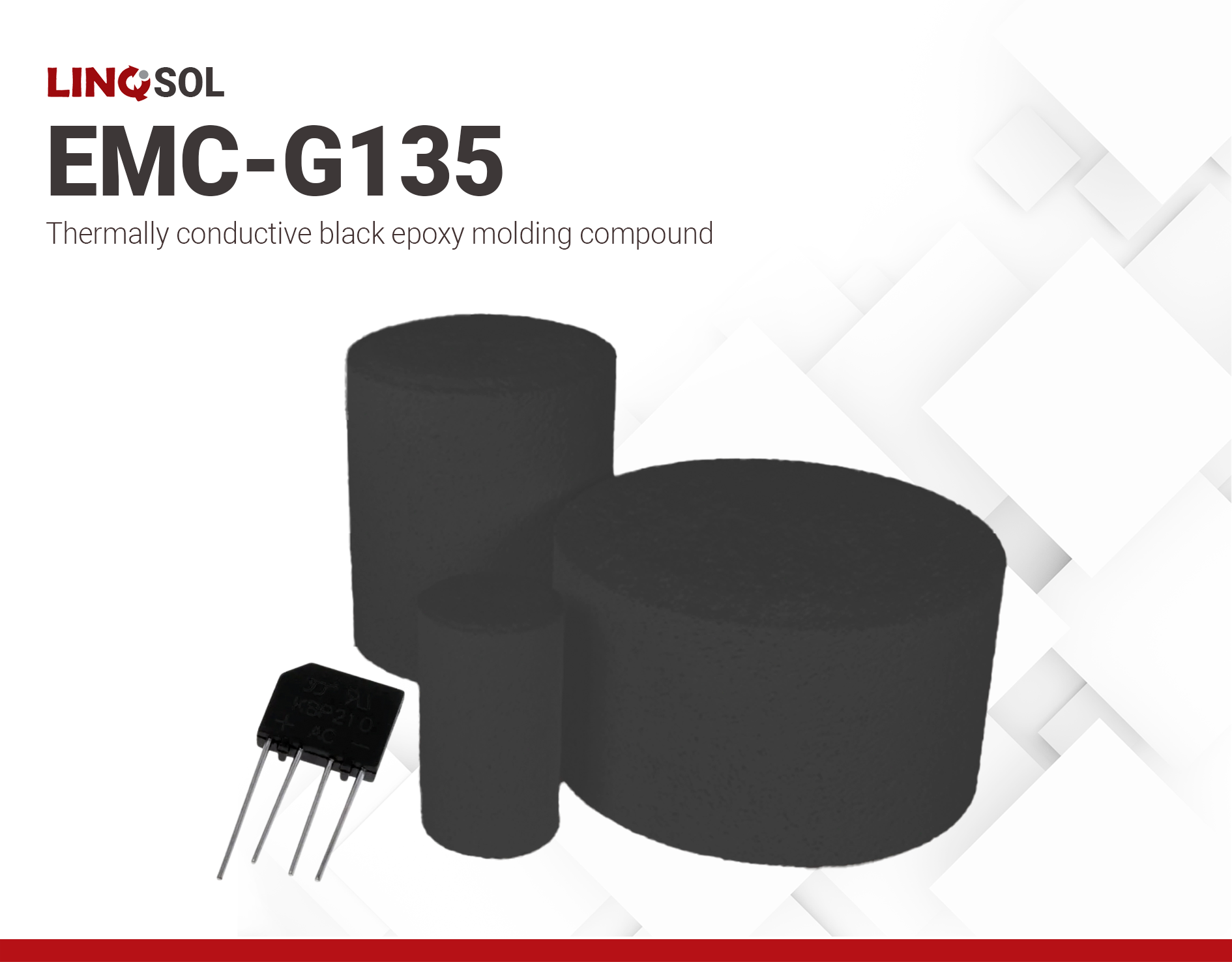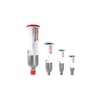LINQSOL EMC-G135 | Thermally Conductive Epoxy Mold Compound
- Green epoxy molding compound
- Low cost thermally conductive molding compound
- Designed for rectifier bridges and SMX packages
Product Description
LINQSOL EMC-G135 is a green epoxy molding compound specifically developed for rectifier bridges (GBU, KBJ, GBS and etc.) and SMX packages. It offers good moldability and low modulus to meeting low-stress requirements. With a thermal conductivity of ~1.7W/m⋅K, it satisfies the heat dissipation required by high-performing packages. G135 boasts of its high-cost effectiveness and excellent workability with more than 500 continuous mold shots.
LINQSOL EMC-G135 guarantees strong performance and outstanding reliability. This product is deliberately formulated without the inclusion of substances prohibited by the European Union RoHS and REACH. Overall, LINQSOLTM EMC-G135 seamlessly integrates advanced material properties, safety compliance, and superior performance to deliver a reliable solution for semiconductor device encapsulation.
Key Features
- ~1.7 W/m·K thermal conductivity — Enhances heat spreading in high-current bridge rectifiers.
- Low modulus (~16 GPa) — Reduces package stress and risk of crack/warp during cycling.
- High moldability (spiral flow ~88 cm) — Fills complex cavities cleanly; supports small gates and long runners.
- 500+ continuous shots — Stable release and low bleed for fewer interruptions and lower scrap.
- Electrical cleanliness (Cl⁻ ~9 ppm, Na⁺ ~4 ppm) — Minimizes ionic pathways that can lead to leakage or corrosion.
- Low moisture uptake (~0.45% PCT 24 h) — Helps maintain insulation and dimensional stability.
- UL-94 V-0 flammability — Meets stringent safety requirements for power electronics.
- RoHS/REACH compliant — Free from substances of concern for global market access.
Reliability Tests Passed:
- HTRB, Tₐ=125°C, V=80%VR * 500 hour
- PCT, Tₐ=121°C, P=0.215atm, RH=100%* 98 hours
- Thermal Cycling Test, -55°C - +150°C * 500 cycles
Application/Suitable For:
- Bridge rectifier packages: GBU, KBJ, GBS; SMX packages
- AC/DC power supplies, chargers, UPS rectifier stages
- Motor drives and industrial controls (bridge diode modules)
- General power conversion, where thermal conductivity and low package stress are critical
Technical Specifications
| General Properties | |
| Color Color The color | Black |
| Filler Content | 76.5 % |
| Specific Gravity Specific Gravity Specific gravity (SG) is the ratio of the density of a substance to the density of a reference substance; equivalently, it is the ratio of the mass of a substance to the mass of a reference substance for the same given volume. For liquids, the reference substance is almost always water (1), while for gases, it is air (1.18) at room temperature. Specific gravity is unitless. | 2.0 |
| Thermal Properties | |
| Glass Transition Temperature (Tg) Glass Transition Temperature (Tg) The glass transition temperature for organic adhesives is a temperature region where the polymers change from glassy and brittle to soft and rubbery. Increasing the temperature further continues the softening process as the viscosity drops too. Temperatures between the glass transition temperature and below the decomposition point of the adhesive are the best region for bonding. The glass-transition temperature Tg of a material characterizes the range of temperatures over which this glass transition occurs. | 160 °C |
| Thermal Conductivity Thermal Conductivity Thermal conductivity describes the ability of a material to conduct heat. It is required by power packages in order to dissipate heat and maintain stable electrical performance. Thermal conductivity units are [W/(m K)] in the SI system and [Btu/(hr ft °F)] in the Imperial system. | 1.7 W/m.K |
| UL 94 Rating UL 94 Rating Flammability rating classification. It determines how fast a material burns or extinguishes once it is ignited. HB: slow burning on a horizontal specimen; burning rate less than 76 mm/min for thickness less than 3 mm or burning stops before 100 mm V-2: burning stops within 30 seconds on a vertical specimen; drips of flaming particles are allowed. V-1: burning stops within 30 seconds on a vertical specimen; drips of particles allowed as long as they are not inflamed. V-0: burning stops within 10 seconds on a vertical specimen; drips of particles allowed as long as they are not inflamed. 5VB: burning stops within 60 seconds on a vertical specimen; no drips allowed; plaque specimens may develop a hole. 5VA: burning stops within 60 seconds on a vertical specimen; no drips allowed; plaque specimens may not develop a hole | V-0 |
| Electrical Properties | |
| Volume Resistivity Volume Resistivity Volume resistivity, also called volume resistance, bulk resistance or bulk resistivity is a thickness dependent measurement of the resistivity of a material perpendicular to the plane of the surface. | 6.0x1015 Ohms⋅cm |
| Chemical Properties | |
| Moisture absorption | 0.45 % |
| Physical Properties | |
| Spiral Flow @ 175°C | 88 cm |
| Curing Conditions | |
| Transfer Pressure | 40-70 kg/cm2 |
| Transfer Time | 17-25 s |
Additional Information
Processing Instructions
Before use, let LINQSOL EMC-G135 reach room temperature for 24 hours. Keep the bag unopened and stored in a dry location with a relative humidity of ≤50% during thawing to prevent moisture contamination.
Use the materials within 72 hours after removing the container from cold storage.
Storage and Handling
LINQSOL EMC-G135 is available in pressed pellets in a wide range of sizes to meet specific customer needs. To ensure product integrity, keep it away from oxidizing materials. For long-term storage, maintain a cold environment. The shelf life at 5 °C is 183 days.
Please note that the provided information is based on available data and typical conditions. For specific applications and detailed test results, refer to the actual test data and conduct appropriate certifications.




